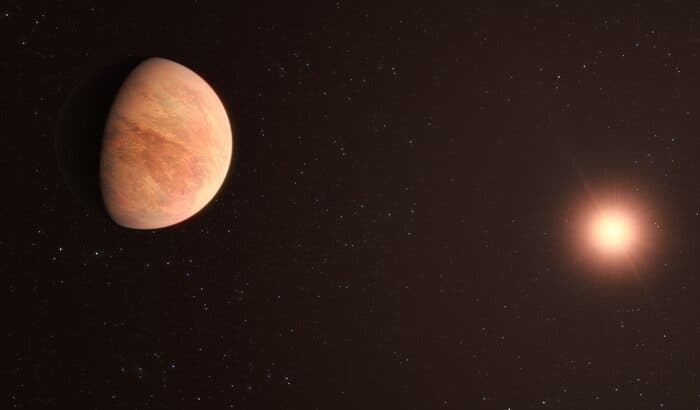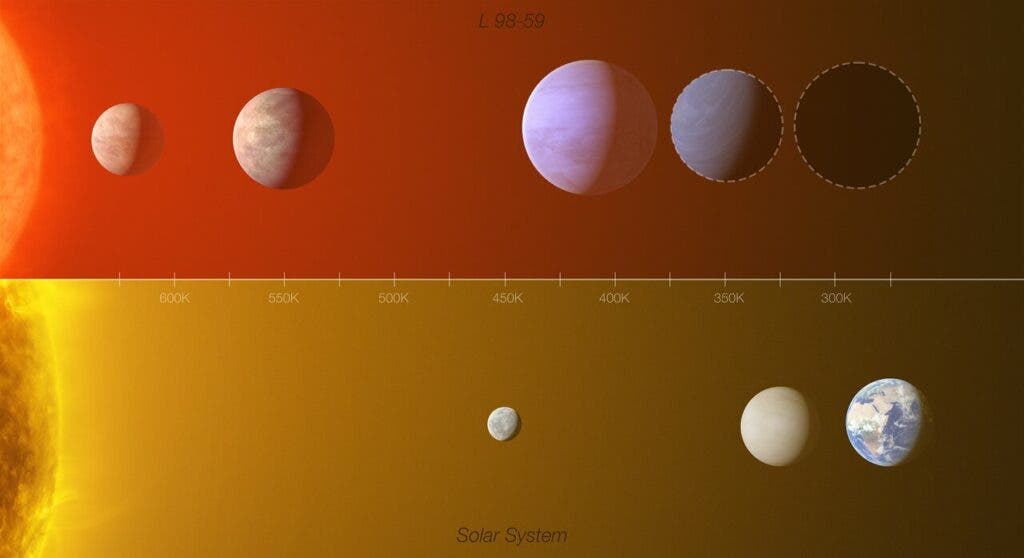In a major breakthrough for the investigations of Earth-like planets outside the solar system, astronomers have used the Very Large Telescope (VLT) to spot previously ‘hidden’ exoplanets orbiting the star L 98-59–located around 35 light-years from Earth.
Amongst the exoplanets, which resemble the inner worlds of our planetary system, is the smallest exoplanet yet to be discovered by astronomers using a detection method known as the radial velocity technique. The innermost exoplanet–which has been designated L 98-59b–has half the mass of Venus.

This isn’t the only important find in the planetary system, however. The team has also found signs of a world dominated by oceans and even the possibility of a terrestrial planet like Earth within the star’s habitable zone.
“We have scrutinized the L 98-59 planetary system. Combining the best instruments currently in operation for the study of exoplanets, achieving the smallest mass measurement using the radial velocity methods,” Olivier Demangeon, a researcher at the Instituto de Astrofísica e Ciências do Espaço, University of Porto, Portugal, tells ZME Science. “We have discovered a new planet in this system and a planetary candidate in the habitable zone. We have also measured the mass and radius of the three inner planets with exquisite precision and inferred their internal structure and composition.”
The research, documented in the journal Astronomy & Astrophysics, represents a major breakthrough for the radial velocity method, already an import tool for exoplanet hunters.
“The radial velocity method measures the movement of the star caused by the presence of the planets,” María Rosa Zapatero Osorio, an astronomer at the Centre for Astrobiology in Madrid, Spain, and Chair of the “Atmospheric Characterisation” working group of the ESPRESSO science team at Centro de Astrobiología (CSIC-INTA), tells ZME Science. “In planetary systems, all bodies–the star and the planets–move around the center of mass, the gravitational central point of the system. Displacement in the velocity of the star is determined via the radial velocity method.”
What Makes the L 98-59 Planetary System Such an Important Find?
As Demangeon explains, there are a number of factors that make the L 98-59 planetary system so special. “At just 35 light-years away it is relatively close to Earth, its central star is bright, it hosts at least four planets, and it might host a planet in the habitable zone,” the researcher says. “Other systems also have a couple of these properties, but it is the combination of all these properties that makes this system unique.”

Astronomers had already investigated the system with the Transiting Exoplanet Survey Satellite (TESS) and using dips in light from the stars caused by exoplanets passing across the face of the stars, finding three planets. The fact that the system contains at least four planets came as something as a surprise to the astronomers, who initially set about investigating the system to measure the mass of L 98-59b.
“This fourth planet does not transit its parent star, we can only characterize it thanks to the gravitational pull that it produces on its parent star. If this planet was alone, we would only have a lower estimate of its mass,” says Demangeon. “However as it has siblings which transit the parent star, we can make reasonable assumptions and reach an accurate knowledge of its mass and orbit. What remains unknown is its radius.”
Not only was the fourth exoplanet around L 98-59b previously undiscovered, but the team strongly suspects there is also a fifth planet in the system.
It isn’t just the number of planets in the system that the team has been able to ascertain. Even though they are as of yet unable to determine the radius of the fourth world, they have also made impressive headway in determining the size and composition of some of the previously discovered worlds.
“We were able to measure precisely the mass and radius of the three inner planets, and we know that these three planets are terrestrial, meaning that they are mostly composed of rocky material–iron and silicates–but their water contents are noticeably different,” explains Demangeon.
The researchers are clear, this new knowledge about the L 98-59 planetary system would not have been available with the impressive observing power of the ESPRESSO instrument and the VLT.
An Important Breakthrough for Exoplanet Hunters
The observation of such a small planet as L 98-59b with the radial method is an impressive feat that was only possible by employing the VLT and the ESPRESSO instrument, an achievement that should solidify its position as one of astronomy’s most impressive tools.
“ESPRESSO is, as of today, one of the best instruments to hunt planets,” says Zapatero Osorio. “It was built with this objective in mind and it is stabilized mechanically and thermally. This means that It delivers radial velocities with unprecedented quality for bright stars like L 98-59.”
Zapatero Osorio adds that the reason that ESPRESSO is so well adapted for radial velocity measurements is that it can see stellar activity in such detail that it no longer obscures the signal presented by small worlds. Hence why it was able to spot an exoplanet with half the mass of Venus, and spotting such a small world could massively improve our understanding of the formation of planetary systems.
“One of the major open questions in physics today is how stars and planets are formed from the protoplanetary nebula, the planetary dynamics within the systems, and their evolution,” says Zapatero Osorio. “Determining the masses of the smallest planets with better signal-to-noise ratio is necessary for understanding how the planetary system was formed and evolved and to find the right place for each planet in the planetary mass-radius diagram.”

The team is unfortunately currently unable to make an in-depth examination of the exoplanets’ atmospheres even with the powerful VLT and ESPRESSO combination. There is hope that this could change in the future will the launch of the James Webb Space Telescope (JWST).
“The next step, the one that I am most excited about, is to attempt the detection and the study of the atmosphere of the three transiting planets. In particular planet d, with its high water content is an ideal candidate,” concludes Demangeon. “Several movies and books have depicted what the atmosphere of terrestrial extrasolar planets could look like.
“With L98–59, we might not have to imagine for very long.”






